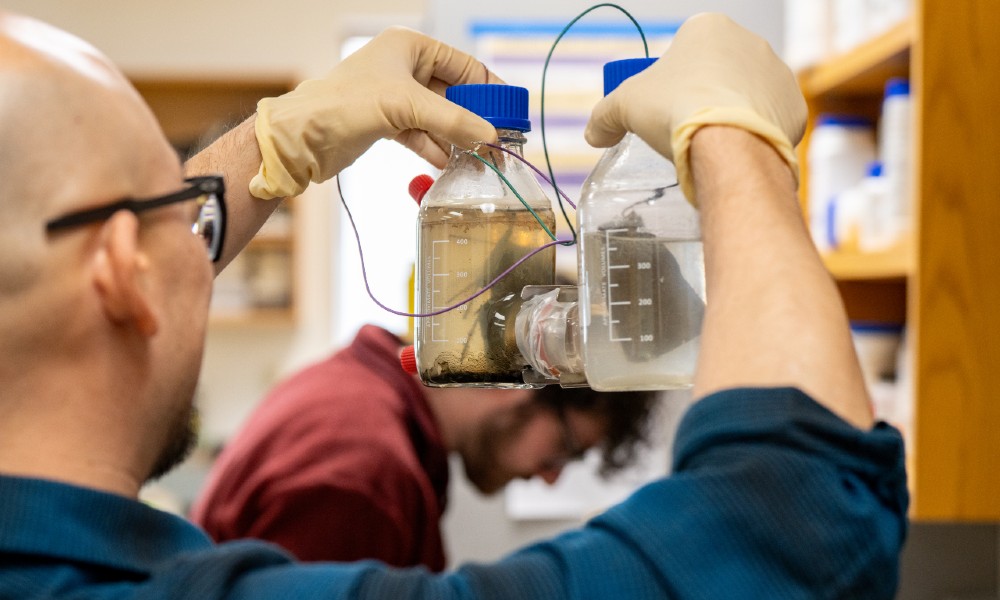Powering the ocean: Turning bacteria into renewable energy
News
Deep in the ocean, where sunlight fades and conventional power sources fall short, bacteria could unlock a breakthrough in renewable energy.
That’s the promise of microbial fuel cells (MFCs)—bioelectrochemical devices that use bacteria to break down organic material and convert it to electricity. If successfully scaled, these fuel cells could provide a long-term power source for deep-sea sensors, reducing reliance on costly battery replacements and making ocean research more efficient.
Cheng Li, a professor in JMU’s Integrated Science and Technology (ISAT) program, is working alongside a team of ISAT students—Erik Leer, Abigail Fischer, Maria Kruml, Davaunte Murray, Manav Rahul, and Ryan Sterling—to turn this idea into reality. With a background in microbial fuel cell research at Oregon State University, Li is designing a stackable fuel cell system that can generate 10 watts of power—an unprecedented achievement in marine environments.
Their research is part of a multi-university initiative led by the University of Maryland and funded by a $7.8 million Defense Advanced Research Projects Agency (DARPA) grant. The project brings together seven institutions to advance marine energy solutions.
Until now, microbial fuel cells have only generated milliwatts of power—barely enough to sustain small sensors. "Ten watts may not seem like much compared to what a coal-fired or nuclear power plant would produce, but it’s a lot for microorganisms," Li said.
Most MFCs must be placed on the ocean floor, where sediment can help create an anoxic environment for electricity generation. However, Li’s team is rethinking this model—designing MFCs that can function at mid-ocean depths, around 100 meters below the surface, rather than relying on seabed sediment. By feeding on naturally occurring planktonic biomass collected from the ocean, these fuel cells can continuously generate power in open water, expanding their potential applications for marine research and autonomous deep-sea technology.
However, scaling up microbial fuel cells isn’t just about increasing power—it also means tackling technical and biological obstacles that come with deploying this technology in unpredictable ocean environments.

One of the team's biggest challenges is biofouling of the fuel cell material, including the cathode and membrane. Over time, unwanted microorganisms accumulate on the cathode and ion exchange membrane of the fuel cell, leading to the degradation of power production. The ion exchange membrane is a critical component that allows positively charged ions to pass through and sustain the electrical circuit. If the membrane becomes clogged or damaged, the efficiency of the MFC drops dramatically, reducing its ability to generate power.
Previous MFC designs struggled with high internal resistance and required large anode and cathode surface areas to generate significant power. If MFCs are to be deployed in the deep sea for extended missions, they must withstand harsh, corrosive conditions while maintaining efficiency.
In addition to the technical hurdles, students are also experiencing the realities of working under strict research deadlines set by DARPA. Each project phase requires teams from different universities to meet specific benchmarks before moving forward. “It gives you a realistic sense of what a research career is like,” says Leer. “We’re not just following instructions—we have to troubleshoot problems, meet deadlines, and collaborate to find solutions. That’s what makes this project exciting.”
|
"This is a chance to gain knowledge in electrochemical and bioelectrochemical techniques and how electricity is produced in the biological system. Through this project, students gain firsthand experience with the science of microbial fuel cells and the logistical challenges of scaling renewable energy solutions." — Dr. Cheng Li |
"I love being able to do research that applies to real-world challenges. We’re working on something that has the potential to change how we power ocean exploration,” Sterling said.
While microbial fuel cell technology is still developing, its potential applications extend beyond deep-sea sensors. Researchers believe MFCs could one day be used for remote environmental monitoring, wastewater treatment, and even off-grid power generation.
“Bacteria are some of the most adaptable organisms on the planet,” Li says. “By understanding how they generate electricity, we’re tapping into a renewable energy source that could have wide-ranging applications.”
For JMU students, this research isn’t just an academic project—it’s a chance to contribute to real-world innovation. "We’re part of something that could have a lasting impact, and that’s what makes this work so rewarding," says Sterling.
